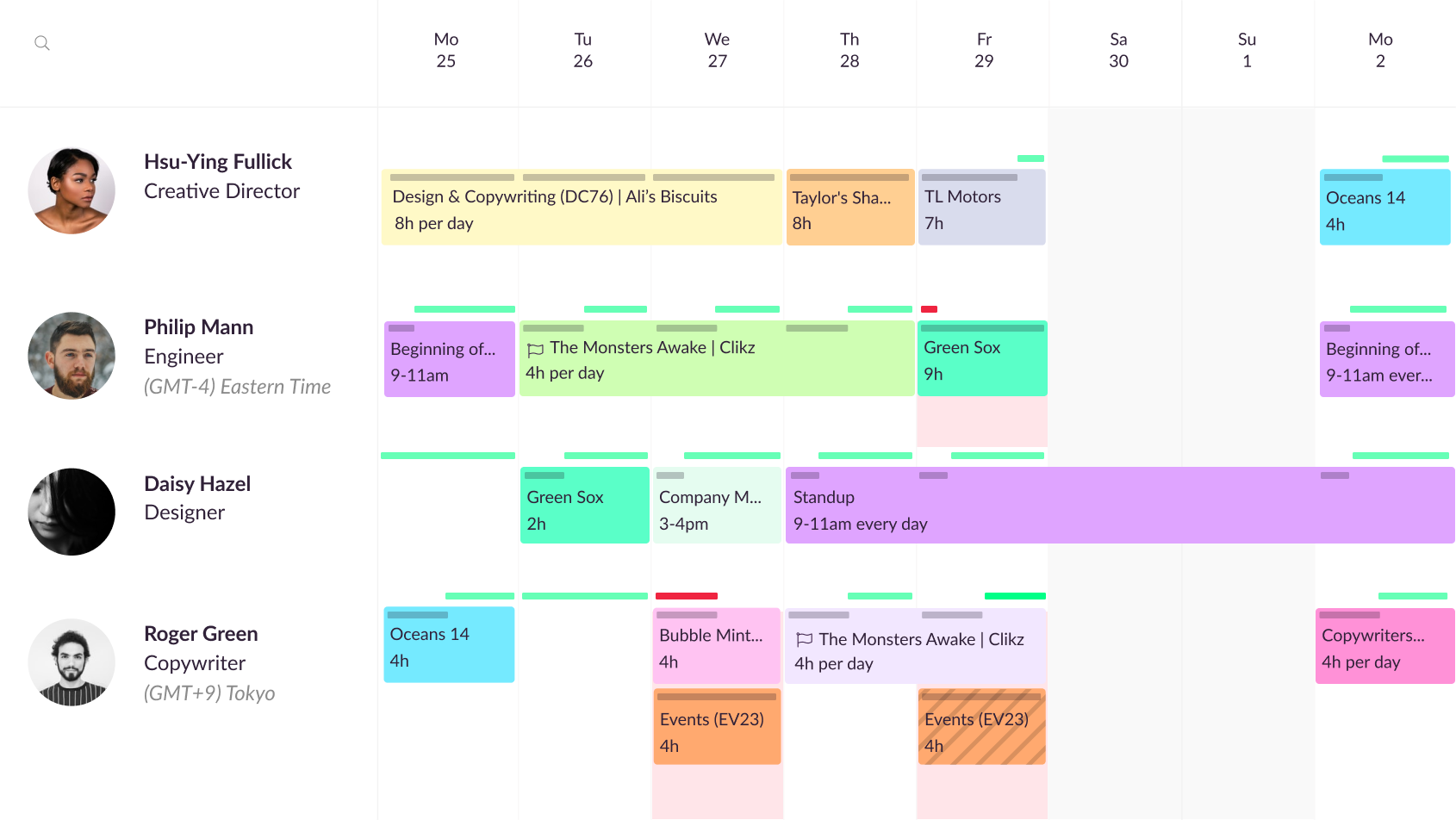Unless you’ve been living under a rock since the COVID-19 pandemic started (#nojudgment), you’ve probably heard over and over that remote work is here to stay.
Owl Labs found that 69% of U.S. respondents work remotely or had worked remotely during the pandemic. Upwork also predicts that around 28% of the American workforce will be fully remote by 2026.
Employees are eager for these opportunities. ZipRecruiter notes jobs listed as “remote” receive 300% more applications than non-remote positions. Additionally, remote workers report increased productivity, better mental health, and greater job satisfaction.
There are definite benefits to these flexible work arrangements for both team members and managers. Still, remote project management can be overwhelming, especially if you’ve never done it before. Remote work brings up new challenges for PMs to overcome, from keeping track of the availability and productivity of all team members to making sure full-time employees and freelancers feel supported.
To adapt and thrive as a remote project manager, follow these 4 tips that’ll set you, your team, and your projects up for success.
In this article 📖
1. Evaluate your project management tools
When working remotely, the technology you use to manage assignments plays an even more critical role in determining project success or failure.
Project management hinges on successful collaboration. Without digital tools that help you communicate with your remote team, see what they’re working on, and manage workloads, though, it’s incredibly challenging to work together effectively.
Review your project management app or software and ask yourself these three questions to determine whether it’s time for new project management software that will better support your remote project management needs:
Can you monitor availability, utilization rates and capacity?
When you’re managing projects across a remote team that has different work hours, different time zones, and different locations, you need a bird’s-eye view of everyone’s updated schedules and workloads. This is key to avoiding over- and under-utilization when resource scheduling. Visibility also helps you avoid remote work micromanagement and messaging people constantly, which can quickly destroy morale.

Resource Guru gives project managers a detailed overview of what everyone is working on and for how long, making it easy to shift workloads and plan future projects without overbooking resources.
Can you quickly search your platform to find the best resource for the job?
Unless you’re directly involved in onboarding, remote working makes it’s easy to miss new freelance and full-time hires. With a searchable directory, you can still find staff with the right skills and availability for a task, even if you’ve never met them.
Can you sync your app or software with other calendar tools?
Remote work generally allows for more flexible schedules. So, someone can have a doctor’s appointment in the middle of the day and work later the next day to make up for it. Calendar integrations helps prevent accidental booking clashes when project planning by factoring in personal time off, so you won’t book someone when they’re actually unavailable.
2. Regularly check in with project team members
You lose a lot of organic opportunities for conversation when working remotely. So, it’s important to proactively reach out to team members to catch up and make sure they have what they need to excel in their roles.
When working alone behind a computer, it’s easy for people to feel like they need to keep pushing through, even when they’re burnt out or upset. And the virtual world makes it harder for managers to clearly tell who’s struggling. A Slack message just doesn’t carry the same meaning as body language, and it’s not like you can just pop by someone’s office if you think they’re having a bad day.
Scheduling regular “temperature checks” will give people a safe space to discuss any problems. Then, you can work together to come up with solutions.
If you don’t make yourself available for these kinds of conversations, you increase the likelihood of employees quitting out of frustration. This can derail your projects and make resource allocation more difficult. Turnover also has a negative impact on team morale, especially in remote environments where losing coworkers can make the “workplace” feel that much lonelier.
Talking with your team is also important for career development purposes. In Buffer’s 2022 State of Remote Work Report, nearly half of remote workers think it’s harder to advance their careers. So, ask about professional goals and look for opportunities to cultivate team members’ secondary skills in future projects. They’ll get experience that supports their growth, and you can place them on more billable work. Win-win.


“Resource Guru has the perfect balance of simplicity and detail. It’s easy to see where issues might arise.”
3. Find ways for your team to connect
One of the biggest challenges of remote project management is figuring out how to develop and maintain personal relationships without meeting in person, (you can’t just drop by Jenna’s office and chat about the latest Bridgerton episode).
Humans are social creatures and crave meaningful interactions with one another. Without a sense of camaraderie and support, remote work can become extremely dissatisfying, making it harder for people to do their jobs well. In fact, a two-year study by Stanford found that most remote workers in their test group who wanted to return to the office listed feeling isolated as the main reason.
While video conferencing on Zoom isn’t the same thing as a face-to-face meet up, you can still help your remote project team come together and keep their spirits up with the following activities:
- Take a virtual coffee or lunch break together. A virtual break room is still a break room. Holding space for non-work-related conversations during the day helps your team connect and breaks up the monotony. It’s also a good way to encourage your busiest staff to take time to relax.
- Share asynchronous “get to know you” prompts. Ask team members to fill out a brief fun-facts survey whenever they have a chance and collect all the responses in one document. This way, staff can learn more about each other and identify shared attributes and areas of interest before they even meet. It’s fun discovering what you have in common with people across the country or globe.
- Acknowledge and celebrate the work your team is doing. Telling your team members “thank you” and recognizing their unique contributions and milestones are small tasks with a big impact. A 10-year O.C. Tanner study found that 79% of people said they quit their jobs due to “a lack of appreciation.” Making sure your remote staff knows they’re all valued through the highs and lows proves that someone always has their back.
- Host virtual after-hours events. After-work hangouts with coworkers were a staple of many professionals’ lives pre-pandemic. Keep the social scene alive with virtual team-building activities like a happy hour, game night, or group fitness class.
4. Maintain your own work-life balance
We often cover the importance of preventing burnout among your team members, but it’s equally important to remind our PM readers to take care of their own mental and emotional wellbeing.
Owl Labs found that over half of remote workers admitted to working more hours than when they were in the office. Maintaining work boundaries and time for rest and relaxation is key to staying healthy, happy, and able to do your best work as a project manager.
Buffer found that remote workers listed the inability to “unplug” from work as their top struggle. This definitely extends to remote project management.

Source: Buffer 2022 State of Remote Work
As Digital Project Manager member Claire Harrington notes, you most likely “feel like a lot falls on your shoulders” due to your high level of involvement in executing every project. Combine that pressure to juggle so many different parts and people with the ability to work anywhere at anytime, and it’s easy to see how overworking can become a problematic habit.
As the saying goes, “you can’t pour from an empty cup.” Take a deep breath and give yourself permission to step back, whether that’s taking a mental health day, deleting Slack from your phone, or refusing to answer emails after a certain time.
Not only is this beneficial for you, but it sets a great example for your team. By keeping clear work-life boundaries, you’ll inspire your team members to do the same, reducing the chances of burnout on their end.
Thoughtful remote project management can boost project success
Change can be tough at first. But once you master remote collaboration, you’ll have happier team members, higher-quality deliverables, and the satisfaction of knowing you’re contributing to a positive shift in how we all approach our work days. And that’s well worth the adjustment period.
Listen to Wunderman Thompson CEO Julian Mercado explain how Resource Guru helps project managers easily manage work and resources across 60 different countries.





